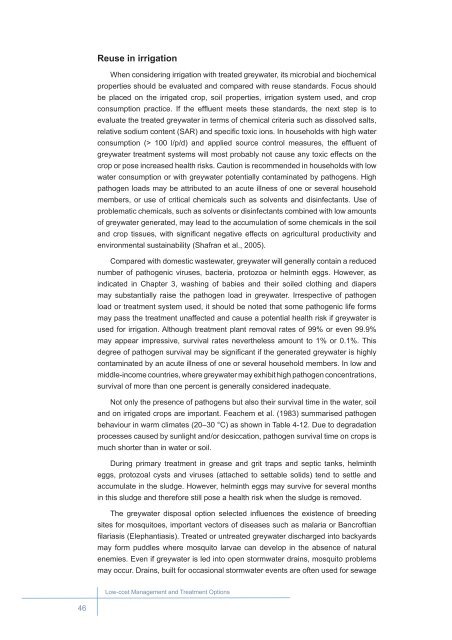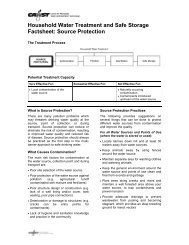Greywater Management in Low and Middle-Income Countries - SSWM
Greywater Management in Low and Middle-Income Countries - SSWM
Greywater Management in Low and Middle-Income Countries - SSWM
You also want an ePaper? Increase the reach of your titles
YUMPU automatically turns print PDFs into web optimized ePapers that Google loves.
When consider<strong>in</strong>g irrigation with treated greywater, its microbial <strong>and</strong> biochemical<br />
properties should be evaluated <strong>and</strong> compared with reuse st<strong>and</strong>ards. Focus should<br />
be placed on the irrigated crop, soil properties, irrigation system used, <strong>and</strong> crop<br />
<br />
evaluate the treated greywater <strong>in</strong> terms of chemical criteria such as dissolved salts,<br />
<br />
<br />
greywater treatment systems will most probably not cause any toxic effects on the<br />
crop or pose <strong>in</strong>creased health risks. Caution is recommended <strong>in</strong> households with low<br />
water consumption or with greywater potentially contam<strong>in</strong>ated by pathogens. High<br />
pathogen loads may be attributed to an acute illness of one or several household<br />
members, or use of critical chemicals such as solvents <strong>and</strong> dis<strong>in</strong>fectants. Use of<br />
problematic chemicals, such as solvents or dis<strong>in</strong>fectants comb<strong>in</strong>ed with low amounts<br />
of greywater generated, may lead to the accumulation of some chemicals <strong>in</strong> the soil<br />
<br />
environmental susta<strong>in</strong>ability (Shafran et al., 2005).<br />
Compared with domestic wastewater, greywater will generally conta<strong>in</strong> a reduced<br />
number of pathogenic viruses, bacteria, protozoa or helm<strong>in</strong>th eggs. However, as<br />
<strong>in</strong>dicated <strong>in</strong> Chapter 3, wash<strong>in</strong>g of babies <strong>and</strong> their soiled cloth<strong>in</strong>g <strong>and</strong> diapers<br />
may substantially raise the pathogen load <strong>in</strong> greywater. Irrespective of pathogen<br />
load or treatment system used, it should be noted that some pathogenic life forms<br />
may pass the treatment unaffected <strong>and</strong> cause a potential health risk if greywater is<br />
used for irrigation. Although treatment plant removal rates of 99% or even 99.9%<br />
may appear impressive, survival rates nevertheless amount to 1% or 0.1%. This<br />
<br />
contam<strong>in</strong>ated by an acute illness of one or several household members. In low <strong>and</strong><br />
middle-<strong>in</strong>come countries, where greywater may exhibit high pathogen concentrations,<br />
survival of more than one percent is generally considered <strong>in</strong>adequate.<br />
Not only the presence of pathogens but also their survival time <strong>in</strong> the water, soil<br />
<strong>and</strong> on irrigated crops are important. Feachem et al. (1983) summarised pathogen<br />
behaviour <strong>in</strong> warm climates (20–30 °C) as shown <strong>in</strong> Table 4-12. Due to degradation<br />
processes caused by sunlight <strong>and</strong>/or desiccation, pathogen survival time on crops is<br />
much shorter than <strong>in</strong> water or soil.<br />
Dur<strong>in</strong>g primary treatment <strong>in</strong> grease <strong>and</strong> grit traps <strong>and</strong> septic tanks, helm<strong>in</strong>th<br />
eggs, protozoal cysts <strong>and</strong> viruses (attached to settable solids) tend to settle <strong>and</strong><br />
accumulate <strong>in</strong> the sludge. However, helm<strong>in</strong>th eggs may survive for several months<br />
<strong>in</strong> this sludge <strong>and</strong> therefore still pose a health risk when the sludge is removed.<br />
<br />
sites for mosquitoes, important vectors of diseases such as malaria or Bancroftian<br />
<br />
may form puddles where mosquito larvae can develop <strong>in</strong> the absence of natural<br />
enemies. Even if greywater is led <strong>in</strong>to open stormwater dra<strong>in</strong>s, mosquito problems<br />
may occur. Dra<strong>in</strong>s, built for occasional stormwater events are often used for sewage<br />
<strong>Low</strong>-cost <strong>Management</strong> <strong>and</strong> Treatment Options<br />
46
















